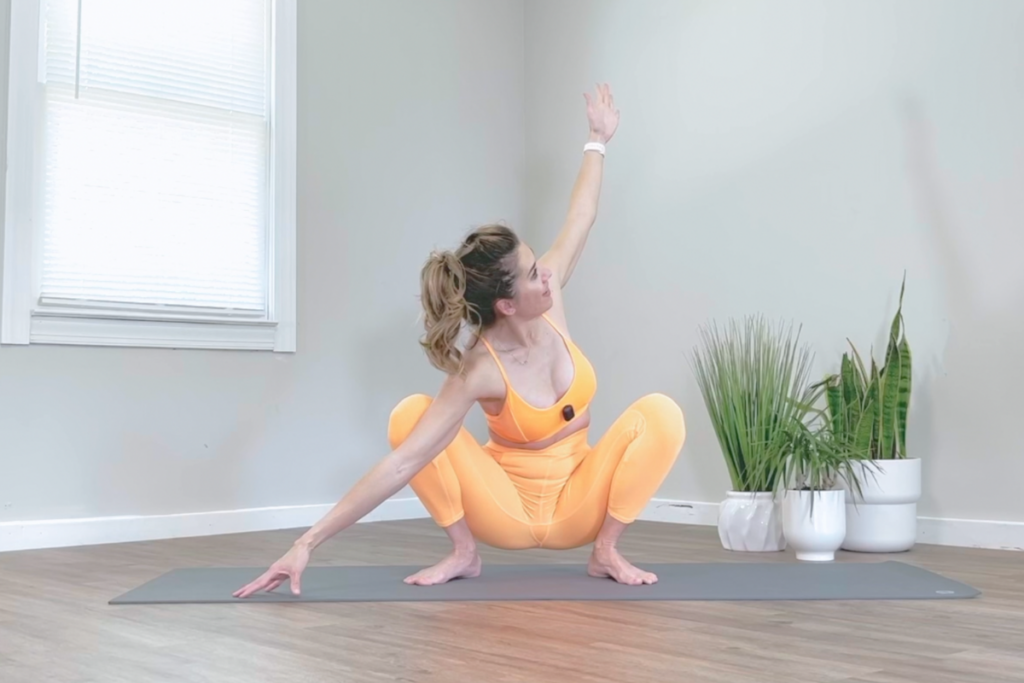
Do you clean your baseboards?
To be honest I’m not much of a cleaner. I do what feels necessary: wipe down the spills from the night’s dinner off of the counters, spray cleaner on sticky spills, and hire someone else to do the rest 🤣
I can’t be the only one that feels that way. That’s why they created robot vacuums right?!
Let’s be real, those baseboards are so far away, and that’s why practicing deep squats is so important.
When we lived in Korea we had halmeoni (grandma) of the towering size of 4’10” who would whisk her way from cleaning the tops of our 9 ft tall windows and drop it like it’s hot into malasana (yogi squat) to dust our baseboards.
I was always astonished by her zippy nimbleness.
People all over the world congregate in malsana/garland pose/yogi squat to have a family meal. Early childhood educators lower their hips into malasana so they can speak eye-to-eye with young humans. And this lady 🙋♀️ and her former cleaning lady, pop-a-yogi-squat to clean those baseboards.
Malsana is how I transition my yoga class from standing to seated – exploring crow pose on our way down – and it’s an excellent pose to practice on a regular basis. Garland pose allows you to rest your leg muscles while fully supporting your upper body. Yet, it keeps you up off of the ground so you don’t dirty your tushy.
What a visual aid? Watch the video.
Malasana doesn’t look impressive or difficult to do, but it is far from easy. There are a few contraindications for doing malasana, but with one-on-one support from a knowledgable professional, many (but not all), people can find comfort in garland pose after some time. If you have had the following please speak to your physical therapist, yoga therapist, or physician before attempting the pose:
*CAUTION* It is not possible (nor is it safe) to achieve malasana for a posterior hip replacement.
If you haven’t already guessed, malasana has many names. Typically “garland pose” is the English translation, but you’ll hear people reference it as “yogi squat.”
No matter what you call it, when done traditionally, malasana is one of those poses that allows you to feel supported while stretching, but also strong all at the same time. Once you get into the pose, sitting in it for some time should feel comfortable.
Find out what’s going on… You know you want to… Privacy is important, I won’t sell your info, I promise.
Lowering from standing is the easiest and most accessible way to move into malasana. You don’t have to work against gravity, and you can maintain the symmetry of the pose.
Important things to note:
There are so many ways to get out of malasana. You can have fun, or keep it strictly functional, but here are a few ideas to get you started.
Option 1:
Option 2:
Option 3:
Option 4:
** Reading Break ** This blog post DOES contain affiliate links of related products I love and they might even be pictured. If you click on a link and purchase a product (or service) it costs you nothing, you MIGHT even get a discount, and I MAY even receive a SMALL commission. This helps me to buy and drink coffee ☕️ in order to keep me awake and provide you with amazing free content 💗 Thank You for supporting my content 💋
Malasana is not easy or comfortable for many people. Chances are if you are struggling to get into the pose you will find yourself in one of the two options below. You might even bounce back and forth between the two until you’ve gained the right flexibility in the appropriate places.
Try walking your feet out a little bit wider.
Try walking your feet closer together. You can also try turning your feet in (or out) a little to see if it makes a difference.
Lifted heels and hips are not the only difficulties people find in yogi squat. Sometimes you CAN get all the way down but you feel uncomfortable. And sometimes you are trying to adjust to correct one of the above 👆but find yourself seesawing between the two. Here are a few ways to prop and adapt the pose to meet your needs.
There isn’t a lot of room to move in malasana, but below are a few ways to switch up malasana so it’s more versatile and exciting.

An easy twist in malasana is a great way to mix it up, it’s also a precursor to taking the bind. For a visual description check out the video.
From malasana:

The bind is never necessary but it can be an excellent way to stretch the chest. So the directions are easier I will describe how to take the bind on one side, swap “left” with “right” to do the bind on the other side. You can also watch this variation of malasana demonstrated in the video.
Start in malasana:
Notes:
Compression work is key for press entrances to inversions.
Psss: If you have no idea what that means, it’s ok. The following exercise is accessible for all and you’ll still find the benefit.
It’s easy to work the compression. All you have to do is engage the core (transverse abdominis) and psoas to pull the thighs close to the core in malasana. Here’s how to experience it:
Note:
You may not be aware of what you feel when garland pose is a challenge for you. Below is a guide of what you should feel when you’re fully in the pose. If your muscles are tight and you’re unable to get all the way into malasana some of the things below may not be felt, and that’s O.K. If you’re more mobile the list below may only feel like slight sensation (also OK).
This section is to help you know EXACTLY what’s going on. Honestly, this would have been nice when I first started teaching yoga. These days my husband always asks for stretches/exercises for specific muscles. This section is also for that.
You don’t need to be an anatomy expert, this can help you general understand your body and its specific anatomy.
Malasana is mostly a pose for stretching, but like in those compression drills above 👆these muscles are engaged to help support the spine or work the compression:
As you guessed many muscles are stretched in garland pose. Your flexibility has a great impact on what muscles will be stretched when you’re in malasana. The pose itself is not a deep stretch but for some, the stretches may feel intense.
I enjoy a good malasana almost every day. Something almost always pops (in a good way) on the way down. A little twist or bind helps me to loosen up my spine, and oddly enough I feel more energized after a few deep breaths. Almost good enough to want to clean my baseboards 😉
How about you? How confident do you feel to pop that yogi-squat to clean your baseboards? Wanna learn more ways yoga can revitalize your household chores? Sign up for my newsletter below.
Find out what’s going on… You know you want to… Privacy is important, I won’t sell your info, I promise.
